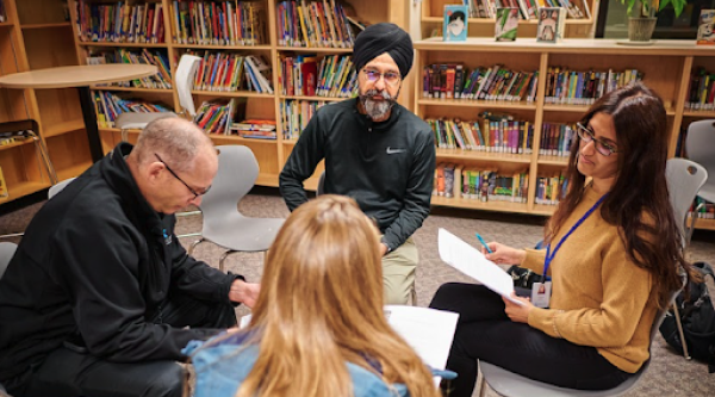Pipelines, Shortages, and Workforces: Why Do We Still Think of Teachers as Workers on an Assembly Line?
Topics

When educators design and create new schools, and live next gen learning themselves, they take the lead in growing next gen learning across the nation. Other educators don’t simply follow and adopt; next gen learning depends on personal and community agency—the will to own the change, fueled by the desire to learn from and with others. Networks and policy play important roles in enabling grassroots approaches to change.
The terms “teacher pipelines,” “teacher shortages,” and “teacher workforce” reflect assumptions about the teaching profession that hide the systemic challenges behind teacher recruitment and retention.
Let’s start with a clear statement: The terms “teacher pipelines,” “teacher shortages,” and “teacher workforce” should be stricken from the discourse on the teaching profession forever.
For one thing, as Peter Greene wrote in a starkly appropriate metaphor in a recent article in Forbes Magazine, “If I can’t buy a Porsche for $1.98, that doesn’t mean there’s an automobile shortage.” For another, just because we still think in archaic 19th-century terms about learning as a linear process like an assembly line and school as a factory, the lack of teachers is not part of a supply chain disruption. And, for any right wing “policy and political leaders who see the current situation as an opportunity to be exploited rather than a problem to be solved” (to cite Greene) and who think anyone can teach, I’d be glad to find you a classroom without a teacher at present in which you can try out your theories of education in actual practice rather than posturing for political gain. To be clear, I am not positioning myself as an expert on teacher education or the career trajectory of teachers, but I have spent my career teaching and working with teachers, new and veteran, and teacher educators.
Greene rightly states that we have a teacher recruitment and retention problem. But he misses several other factors that, taken together, make it a much larger systemic challenge than just a shortage or just a recruitment and retention problem. However, we won’t be able to see the systemic issue if we don’t first challenge some basic assumptions about those three terms: pipelines, shortages, and workforces.
First, Let’s Get Rid of the Term Workforce
We might start simply with a report summarizing research about the teaching profession from the National Education Policy Center (NEPC) at the University of Colorado at Boulder. Of course, low salaries are a huge issue in education. In many communities across the U.S., teachers cannot even afford to live where they teach. People in other fields with similar levels of education, experience, and expertise make significantly more than teachers. Underlying this discrepancy is a set of beliefs that goes back to the late 19th century, that teaching is mostly a woman’s job (though, ironically, before then it was mostly men who taught); that women should be paid less than men; that the knowledge about teaching, learning, and the organization of school resides primarily at the “top” of the education bureaucracy; and that those jobs at the top should be reserved mostly for men. The last assumption, which Greene also describes in his piece, is that anyone can teach. If we combine all these assumptions with the still-prevalent view that learning is like an assembly line, with knowledge being added to little brains as they progress in linear fashion from preschool through high school, thus helping to reinforce the idea of teachers as low-skilled assembly line workers, then the rationale for low salaries is complete. Finally, how often do we hear people talking about the “doctor workforce” (never), or the “university professor workforce” (less frequently)? We should strike the term “workforce” from our vocabulary since it embodies this whole set of assumptions about teaching requiring nothing more than low-skill labor with interchangeable people performing that labor.
Second, Let’s Get Clear about the Reasons Teachers Decide to Stay or Leave the Profession
Salary, although important, turns out not to be the only reason that teachers cite for their dissatisfaction with the career, NEPC reports, and other reports agree. NEPC describes as equally important, the “...working conditions in schools. Especially important is the amount of ‘voice’ teachers have into key decisions in their schools. [Richard Ingersoll and Tuan Nguyen] recommend policymakers and district leaders incorporate teachers’ input into the decision-making process to improve retention. Moreover, teachers have valuable insights to offer, and policy changes would be better informed if they considered the experiences of educators.” It turns out that the culture of a school is highly significant when it comes to the early experiences of newer teachers and the decisions they as well as mid-career teachers make about staying in the profession. In many urban schools, fully two-thirds of new teachers leave the profession by the end of their third year of teaching. Currently, increasingly large numbers are leaving at the mid-career level.
What is at play here? If we define a “positive school culture” in an operational way, we can ask questions like these: When a new teacher arrives at their first school, do they feel welcomed into a community of professionals, a community of shared learning and practice, by people who for the most part have positive feelings about their colleagues, their students, and their administration? Are they immediately incorporated into, even more so, apprenticed into, an existing team, whether that is a grade level team, a subject area team, or a smaller learning community or pathway team, where teachers share students and work together to design their curriculum and improve their practice? Young Whan Choi, author of a recent article reflecting on how he learned to teach (“Even though I earned a master's degree from one of the most prestigious teaching institutions in the country, I really learned to teach during my first year of teaching.”), argues that extensive coaching, mentoring, and co-teaching alongside experienced, competent, veteran teachers would benefit new and pre-service teachers, and their students. What effect might that have on positive professional culture as well as on skill development, and thus on retention?
More questions: Do all teachers feel seen, valued, and supported by their administrators, by the community, and by each other as competent professional decision-makers about their professional skills and capacity to know their students and those students’ needs well? To know their content well? As such, do they have collective authority over most decisions affecting their curriculum and the structure and process of their professional learning opportunities? Do they have sufficient time and space for individual and collective planning? How much work do they have to take home each night or do over the weekends? Are there sufficient student and teacher support services so that teachers do not feel they are solely responsible for the whole child needs of their students, but are working as a team to surround the young people in their care with what they need to become healthy, competent, and confident learners, and eventually thriving citizens?
Conversely, if we ask about what leads teachers to leave, is there little opportunity for newer teachers or those further along in their careers to feel part of a professional community? How often do teachers feel they are not respected professionally? Do they lack authority over most professional decisions? Do they feel isolated, alone in their classroom with little chance to interact with other adults in collegial ways? Do they feel overwhelmed by the sheer numbers of students they must teach and how much it takes to address their social and emotional wellbeing needs, not to mention their academic learning, every day? If we think about it this way, then the problem is not a teacher shortage; the problem is an unsustainable system with a lonely and overwhelming set of teaching tasks at the center of it, too many additional and distracting non-teaching tasks, and not enough support, as well as way too low a salary. All this counts.
Teacher Preparation Programs Play into the Pipeline Trap
Seeing teacher preparation, teacher recruitment, and teacher retention as a linear and individualistic pipeline contravenes the holistic image the teaching profession needs. As I mentioned above, apprenticing teachers into the professional culture and practices of their schools before they get their own class to teach is based on the assumption that while you can teach content in an education class, you have to learn pedagogy in actual practice. In addition, in newer approaches to teacher development in the U.S., teachers progress through their preparation programs in cohorts so they feel part of, and learn how to participate in, a professional culture and community right from the start. And they also start interning in classrooms right from the start, so they can see how the content of their teacher prep classes can be applied as well as the limitations of the theories they are being taught.
These ways of teacher development make a lot of sense. But if student teachers then graduate from their program—no matter how good the academic preparation, no matter how supportive the cohort model—and go out to apply for their first job, get recruited, hired, and “on-boarded” (another term from the corporate world we should get rid of), as individuals, and then dumped into their first classroom all alone, even if they have a BTSA (Beginning Teacher Support and Assessment) coach, all the collective support and collegiality is lost. Again, there are just too many layers of assumptions built into this linear and individualistic approach. If we challenge many of these as resulting from White supremacy culture (White western emphasis on individualism, linearity, and a segmented, sequential nature of processes, competition, scarcity, perfectionism, etc.), and apply a wholly different mental model, we might restructure and reculture the process completely. The development of teachers needs to be thought of as a collectivist effort, and it needs to be thought of in non-linear ways. How?
Is a Teacher Residency Program Sufficient?
There are increasing numbers of teacher preparation programs that have created a teacher residency approach to working collaboratively with specific school districts and schools. In these, the expectation is that teacher candidates in cohorts are involved in a residency program in a designated school right from the start. Over the course of their preparation program, they are already becoming embedded in the culture of the school where they will eventually teach, as a cohort, even as they apprentice into the profession. They then get hired to teach in that school, and maintain their cohort as they become integrated into the larger “cohort” of that school’s professional community. This approach overcomes one aspect of the ideology of a “pipeline:” its linear, sequential nature. It also overcomes the hyper-individualism that mitigates both collective support and the experiential development of professional culture. Finally, it breaks down the fragmentation that happens when a new teacher leaves their preparation program and starts to work in a school that may or may not have any of the same cultural norms that their preparation program had.
If we went even further, in an approach that I’ve seen working in several schools, we might have the professors from teacher preparation programs co-teach their “classes” with experienced teachers in the schools where the residencies are taking place, in regular teacher team professional planning and learning spaces (“common planning time,” “professional development time”). That would have the additional benefit of assuring that the professors’ content and pedagogy were compatible with and addressing the specific realities on the ground in the schools where their students were in residence. By focusing on the collective and overlapping domains of learning and experience, rather than an individual’s linear sequence of experiences, this approach challenges all the assumptions about the linearity, sequential nature, and individuality that underlie the idea of a pipeline. So we can now get rid of that term too.
What about “Retention?”
Retention is another term I strongly dislike. Why do many teachers stay in the profession? Well, for starters, they love teaching and they love young people. Very few teachers who stay do not love what they are doing. But that is no excuse not to pay them a decent salary or provide professional working conditions that are sustainable. Teachers should never be seen as martyrs to the cause of public education. But what are other considerations? Why do experienced teachers leave? As I described above, most reasons have to do with the culture of the school and district that people teach in, and the unsustainable nature, overall, of the profession. I have rarely met a really good teacher, one who should be staying, who says they are leaving the profession because they don’t like the kids. Teachers often cite the immense pressure to do other things besides teach, and I don’t mean addressing the needs of the whole child they are teaching. Because schools are nested in school districts, and school districts are highly bureaucratic places, there is often an assumption by others in the bureaucracy that the role of the teacher is to participate in the rituals of bureaucratic life, most of which involve filling out innumerable forms over and over for almost anything that needs to happen. Most of this is unnecessary, and none of it should be the teacher’s responsibility. School and district administrators could make a significant improvement in teacher working conditions just by getting all this procedural compliance work off their plates. No teacher needs to know the “org key” to purchase different classroom materials, or on which line on a purchase order different information should be placed, or which funds should be used to pay for buses to an academic event off campus.
But beyond all that, teaching is relentless. The demands on a teacher’s attention, professional skill, and decision making, from the largest to the most micro decisions, never cease, are in force in every minute of every day, continue during too-short lunch and prep periods, even keep them from going to the toilet as needed, then continue at home in the evenings and over the weekend. It’s a tsunami of neediness. No other professional except for possibly urban emergency room doctors and nurses faces such relentlessness, and even they can leave most of it at work when they go home.
In most advanced nations around the globe, teachers have much more time for planning, preparing materials, grading, and professional learning with their colleagues. In many, teachers see fewer students each week or year. Some people would suggest that teaching is an early, first career, not a lifetime career, and we should keep a supply of young and energetic people rotating into and out of schools. Most of us who have watched an experienced teacher interact with their students and their colleagues would argue this represents a serious misunderstanding of what quality teaching looks like and requires. We need to support that longer term development in sustainable ways with everything we have.
Which brings me to the final point about retention. I’ve watched so many teachers as they get more and more tired out from that daily tsunami of teaching a full load (too full a load?) along with all their other responsibilities wish for a better design for career advancement than having to go into administration or into a district position. Why do teacher salary and teaching structures or situations stagnate at about ten to twelve years? Having to shift roles into something that they are mostly not prepared for, such as an administrative role, makes little sense, unless administration is the career advancement track they are interested in (and then they will still need considerable additional training for that role). Why can’t a teacher who demonstrates to their colleagues, their students, and their administration that they have developed into a truly exceptional educator become a master teacher, stay in their school (because they know their colleagues and understand the context, not just the content, of their teaching), continue to teach some classes, and spend most of their time coaching other, newer teachers, or leading professional learning opportunities? And do that with a salary scale and advancement that matches that of a teacher who goes into administration? The current HR models for teacher advancement are as outdated as other aspects of the career trajectory. These need to change too.
So, in Sum, Promise Me! No More Talking about Workforces, Shortages, or Pipelines!
To summarize… We need to pay teachers a salary commensurate with their education, experience, and expertise, and aligned with the salaries that other equally well educated and skilled professionals make. We need to assure that the working conditions and the cultures of schools are professional and sustainable. We need to think of the preparation, recruitment, professional life in schools, and retention policies and practices as one system of professional learning and culture building. We need to see these as a collective capacity building experience and responsibility across institutions and roles. This should not be seen as a linear, individualistic, and mechanistic process, like an assembly line. We need to stop thinking of teachers as being passively moved along from one institution to another like widgets in a supply chain. We need to rethink career advancement opportunities and the salary scales that apply to them. We need to get bureaucratic administrivia off teachers’ plates and protect them from other burdens and barriers to effective teaching. All these points add up to an argument countering thinking of our current situation as a “teacher shortage.” It's not a shortage; it's a systems redesign challenge to address an unsustainable system across all those ways of thinking.
We need to recognize that teaching is the hardest job there is, that it serves as the cornerstone of a fundamental and essential aspect of a working democracy (public education that develops informed and knowledgeable, engaged citizens). We need to make sure we are redesigning a profession that is honored and sustainable. Then we would be done with the unexamined assumptions and bad habits of mind that lead us to use terms like workforce, shortage, and pipeline.
Photo at top courtesy of Abbotsford School District.




